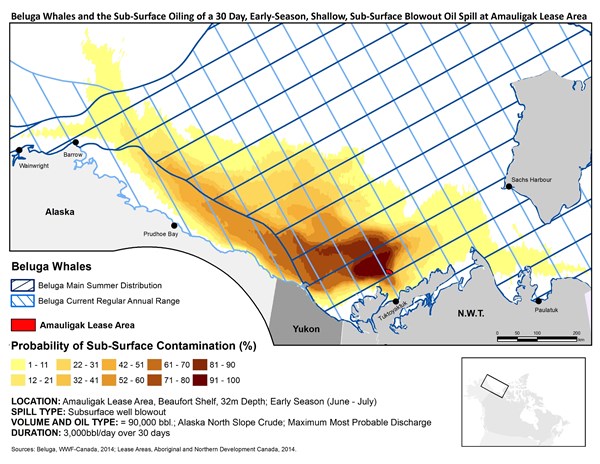TORONTO, July 25, 2014 (GLOBE NEWSWIRE) -- Today, WWF-Canada released new research mapping a range of oil spill scenarios in the Canadian Beaufort Sea, which is home to an incredibly rich diversity of species and key to the livelihood of the region's Indigenous peoples. The study, which used cutting-edge scientific and modelling technology, is being shared to help advance discussions about development in the Canadian Arctic, informing northern residents and decisions-makers about the potential impacts of spills so they can make well-informed choices to reduce these risks.
The results of the research – including the full report and a summary report – are available at arcticspills.wwf.ca. Site visitors can not only watch oil spills spread but also see how these spills would overlap with areas important for the health of Arctic species and ecosystems, ultimately affecting the local communities that depend on them for so much.
Quotes
"This is an issue of great concern. Development in the Arctic is fraught with risks, and drilling for oil in the Beaufort Sea is exceptionally risky, especially in deep waters. We want to ensure that Beaufort Sea communities and other decision-makers have the best possible information to shape their choices. This work will help ensure that we all can see how even minor spills can have major impacts, and that these potential consequences are fully considered in planning decisions."
- David Miller, President and CEO, WWF-Canada
"All aspects of the Beaufort Sea, the coastline and its wildlife are important to Inuvialuit peoples. One spill in the Beaufort would be devastating to the Inuvialuit and the marine species and wildlife that we harvest. By better understanding how oil spills travel and affect these regions, this will allow Inuvialuit to better prepare for development in our region in a safe manner, and how to prepare to avoid the risks to the water, marine species, and wildlife that have sustained our communities for generations."
- Frank Pokiak, Chair, Inuvialuit Game Council
The Research and Results
Research Background
In 2013, WWF commissioned RPS Applied Science Associates, Inc. (RPS ASA), a world leader in modelling the transport, fate, and biological effects of oil and chemical pollutants in marine environments, to evaluate different types of oil spills originating in the Beaufort Sea. RPS ASA used cutting-edge computer modelling software (Spill Impact Modelling Application) to estimate the spread and fate of future potential oil spills associated with increased ship traffic and offshore petroleum exploration and development in the Beaufort Sea.
Various scenarios were analyzed for four types of oil spills – shipping spill, trans-boundary spills, shallow water blowouts and deep water blowouts – resulting in a total of 22 scenarios of unique oil spills, mapping their spread, the potential impact on the water and shoreline, and interaction with the sea ice, wildlife and ecologically significant areas in the region.
Key Conclusions
- Spilled oil surfaces rapidly and is easily trapped in sea ice, making it difficult to contain or clean up and spreading oil to areas far from the spill site.
- Spilled oil may travel considerable distances to the west and north of the spill site, both due to wind and currents in open water and when trapped and drifting within sea ice, affecting important habitat for a wide range of species.
- Spilled oil originating in Canada could be an international issue; there is a relatively high chance that oil spilled in Canadian waters could reach U.S. shorelines and affect communities there, as well as those in Canada.
- Using chemical dispersants to address spills at deep water blowout sites may result in potentially toxic concentrations of dissolved oil components in the water column along the Beaufort shelf, contaminating an area that is home to a diverse range of species and essential to the health and productivity of Beaufort Sea ecosystem.
Full report available at:
http://awsassets.wwf.ca/downloads/wwf_beaufort_sea_oil_spill_modelling_full_report_rps_asa.pdf
Summary report available at:
http://awsassets.wwf.ca/downloads/wwf_beaufort_sea_oil_spill_modelling_summary_report.pdf
About WWF-Canada
We are creating solutions to the most serious conservation challenges facing our planet, helping people and nature thrive. www.wwf.ca
A photo accompanying this release is available at http://www.globenewswire.com/newsroom/prs/?pkgid=26724
